An obese cat is a cat that is significantly overweight, with so much body fat that the cat’s health and overall well-being are affected.
Obesity in cats is typically defined by a body condition score that considers the cat’s physical appearance and palpable fat cover. Cats with a body condition score of 8 or 9 on a 9-point scale are considered obese. Your vet clinic should have a body score model you can look at and touch, but basically, if you can’t feel your cat’s ribs, she’s overweight.
Cat weight loss helps an obese or overweight cat achieve a healthier body weight through a combination of dietary changes, exercise, and, in some cases, medical intervention. Weight loss is important for obese cats because excess body fat can lead to various health issues, including diabetes, joint problems, heart disease, and an overall decreased quality of life.
So, how heavy should your cat be? Well, that depends on the size of your cat and its breed. However, a healthy weight for an average-sized adult cat is 8 to 12 pounds. You should be able to feel your cat’s ribs and spine; she shouldn’t have a floppy, pouchy belly, and her weight shouldn’t prevent her from moving freely and easily.
But what do you do if your cat is overweight? Several ways to help your cat shed those excess ounces include gradually increasing her exercise through play and training, managing her diet, perhaps switching to a low-calorie product, and cutting back on treats.
An obese or overweight cat typically has a shorter life expectancy, and she will probably suffer from health problems, including diabetes, cardiac problems, and arthritis, as she gets older.
So, as a caring cat owner, you must help your cat get down to a healthy weight. Read this guide to find out how!
What Is Cat Obesity?
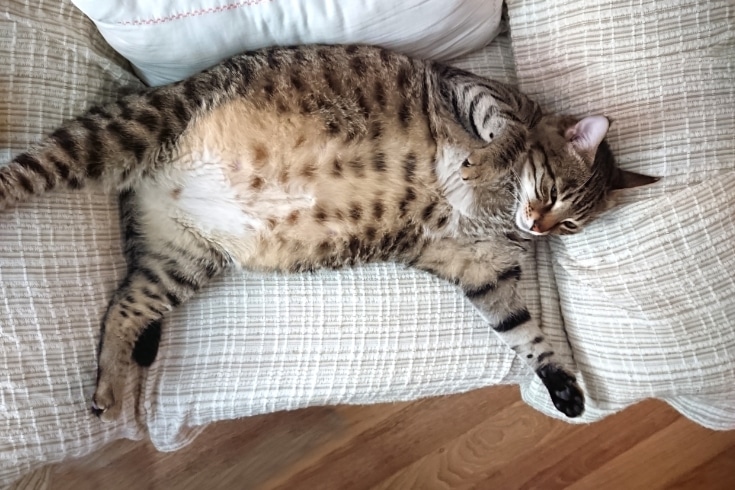
Cat obesity is the term used to describe cats that are significantly overweight and so fat that their health and overall well-being are badly affected. Vets consider a cat to be obese when she is 20% over her ideal body weight.
Obesity in cats is measured by a body condition score that assesses the cat’s fat cover. An obese cat has a body score of 8 or 9 on a 9-point scale. Basically, if you can’t feel your cat’s ribs, she’s probably obese or at least overweight.
What Is The Difference Between Overweight And Obese?
When a cat is described as overweight, it means the cat’s weight is above the ideal range but not exceedingly so. Generally, a cat that weighs 10% to 20% more than the ideal is overweight.
Obese cats are more severely overweight, typically being over 20% heavier than the ideal for their size and breed. These kitties are more likely to develop weight-related health problems like diabetes, arthritis, and heart disease.
What Is Considered A Healthy Cat Weight?
Healthy cat weight depends on the age, size, and breed. However, an ideal weight for most average-sized domestic cats would be 10 lbs or 4 to 4.5 kilos. Some larger breeds can weigh as much as 25 lbs or 11 kilos, while smaller ones can weigh just 5 lbs or 2.2 kilos.
According to the Guinness Book of World Records, the world’s fattest cat was an Australian moggy called Himmy back in 1986 who weighed in at a mighty 46.07 lbs before passing away in the same year at the tender age of just 10.
1998 Guinness World Records dropped the title to discourage owners from overfeeding their pets.
How Much Should An Adult Cat Weigh?
The average weight of an adult housecat should be around 10 lbs or 4.5 kilos, depending on the breed and size of the cat. However, if you’re wondering how heavy should my cat be, take a look at the chart below to get an idea.
Of course, we recommend taking a trip to your vet clinic for a more accurate assessment, where your pet can be weighed on an accurate s
Cat Weight Chart
To help you work out the average cat weight for your pet, we’ve produced this cat obesity chart. Take a look at the images below to see if you have an overweight kitten on your hands, and then take steps to get your feline friend back in shape if necessary!
The body score chart below shows you at a glance whether your cat is overweight or just about right. Take a look at your cat from the side and from above to work out whether he is overweight or not.
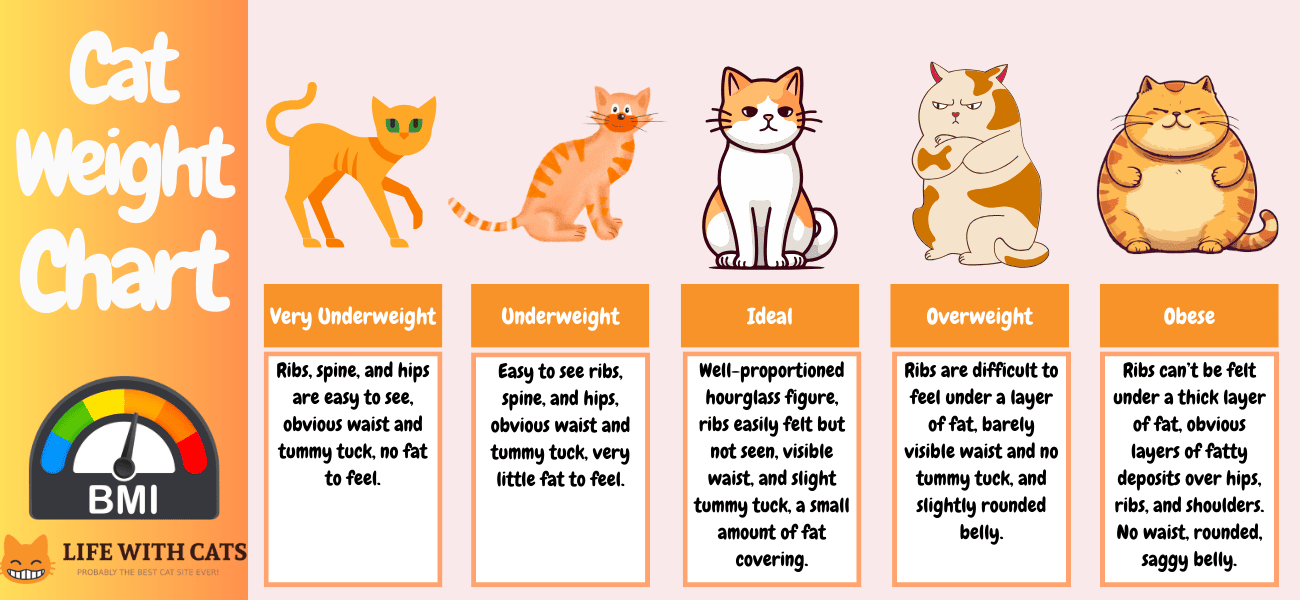
Breeds
Different cat breeds have different frame sizes and can, therefore, weigh more or less than the average. In the following chart, you can see that small breeds, such as the tiny Singapura, typically weigh much less than larger ones which tend to be the fattest cat breeds like Maine Coons and Norwegian Forest cats.
| Small Breeds | 5 To 10 Pounds (2.3 To 4.5 Kg) |
| Medium Breeds | 8 To 12 Pounds (3.6 To 5.4 Kg) |
| Large Breeds | 10 To 25 Pounds (4.5 To 11.3 Kg) |
By Age
Cat weight also varies by age, with kittens obviously weighing less than mature adults and senior cats.
| Kitten (Up To 6 Months) | Birth: 85-115 grams (around 0.2 pounds)1 month: 1 – 1.5 pounds (0.45 – 0.68 kg)2 months: 2 – 2.5 pounds (0.9 – 1.13 kg)3 months: 3 – 3.5 pounds (1.36 – 1.59 kg)4 months: 4 – 5 pounds (1.81 – 2.27 kg)5-6 months: 5.5 – 7 pounds (2.49 – 3.18 kg) |
| Young Adult (6 Months To 2 Years) | 6 months to 1 year: between 7-10 pounds (3.18 – 4.54 kg)1 year to 2 years: 8-12 pounds (3.63 – 5.44 kg) |
| Mature Adult (2 To 10 Years) | 8-12 pounds (3.63 – 5.44 kg) |
| Senior (10 Years And Older) | Varies, depending on breed, size, and health |
Note that many senior cats might experience some weight loss due to age, health conditions, or dental problems. However, some might also gain weight if they become less active. The typical weight range for seniors is similar to adult cats, but it’s crucial to monitor your elderly feline friend and ensure any significant weight changes aren’t due to health issues.
How To Tell If Your Cat Is Overweight Or Obese?
To know if your cat is overweight or obese, there are quite a few checks you can carry out.
Your vet should tell you if your furry friend is a tad on the porky side at your pet’s regular checkups and vaccination booster visits. Body condition scoring and feeling your cat’s body to assess belly fat and rib coverage can tell you if Kitty is carrying one too many pounds, and you can weigh your cat at home, too.
Observation
My cat Spotty started gaining weight after being neutered, largely because he became less keen to go out in the garden and took to spending all day sleeping on the sofa. It became obvious within a couple of weeks that my pet was gaining weight, so I took action by starting him on a new, lower-calorie diet, cutting down on treats, and instigating a daily exercise program.
So, by observing your cat, you’ll quickly see if she’s getting fatter and work out why. Then, you can take steps to get your feline back in shape!
Body Condition Scoring
As mentioned above, body condition scoring is an excellent way of telling if your cat is overweight. You can refer to a body condition scoring chart online or ask to see one at your vet clinic.
Simply look at the images on the chart and find the one that most resembles your cat. That way, you can usually see at a glance if your cat is within the correct physical shape for her age, size, and breed.
Note that female cats generally way less than male cats, so if you have a girl, she should definitely not be any heavier than the top weight for her breed or size.
Weigh Your Cat
Although most people don’t have a set of veterinary scales, you can weigh your cat at home. Simply weigh yourself on an accurate set of bathroom scales, then weigh yourself again, holding your cat. Subtract the first figure from the second, and you should be left with a reasonably accurate estimate of your cat’s weight.
Comparison To Breed Standards
As mentioned earlier, some cat breeds weigh more than others, so you should check your cat against the breed standards to determine whether she is overweight or just about right.
For example, Maine Coons tend to be on the large side, with an average weight of 15-25 lbs (6.8 – 11.3 kilos), so if your Maine Coon weighs more than 25 lbs, she’s overweight.
Consult A Veterinarian
If you are unsure if your cat is the correct weight or is too heavy, or if you’re struggling to get some excess weight off your cat, always consult your vet for advice and guidance on what to feed your cat and how best to exercise her to facilitate weight loss.
Feel For Rib Coverage
You should be able to feel your cat’s ribs quite clearly through her coat when you stroke her. Obviously, your pet shouldn’t be all skin and bones, but she should feel athletic and muscular and you should be able to feel her ribs.
If all you can feel is blubber, your cat is overweight, verging on obese!
Assessing Belly Fat
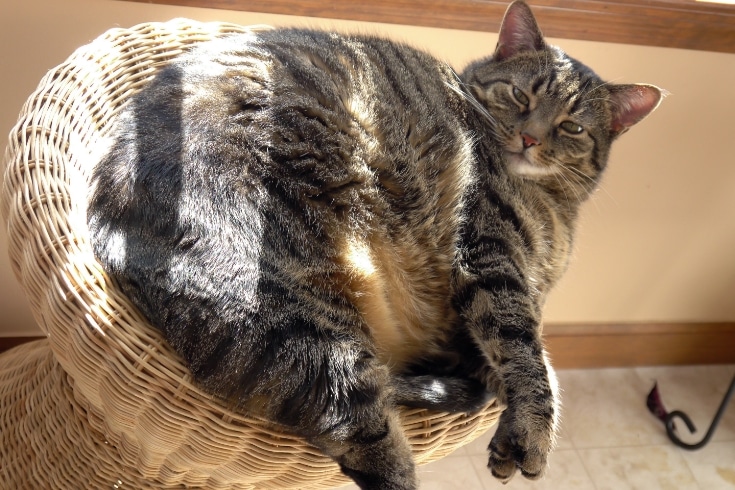
Although older cats can appear “pouchy” and have noticeable belly fat, that often indicates a senior cat and doesn’t necessarily mean she’s overweight. However, if you can’t feel your cat’s ribs and she has a sizeable wobbly belly, the chances are she’s too heavy for her size.
Neck And Collar Area
If your cat’s collar seems too tight and you can’t fasten it as easily as you once could, there’s a good chance she’s overweight. You should be able to feel your cat’s neck clearly and it should not be thick and flabby.
What Are The Health Risks For A Cat Being Obese?
The risks of your cat becoming obese can be high. In fact, a seriously overweight cat can have a shorter life expectancy than one that’s fit and the correct weight for her size. Health risks for an obese cat include heart disease, diabetes, joint problems, respiratory issues, and immune system suppression.
Here’s an overview with a little more detail about the health risks for an obese cat.
Diabetes
Diabetes mellitus is a serious health condition that happens when the cat cannot use sugar effectively or control the sugar levels in her blood. Insulin is made in the pancreas and is crucial for regulating the use and storage of blood glucose. If the cat’s pancreas doesn’t produce enough insulin, that condition can be life-threatening.
There are two forms of diabetes, neither of which can be cured, however, cats with this condition can be successfully managed through exercise and nutrition. Some cats need insulin medication to control their diabetes, and your vet will advise you on that.
Joint Problems
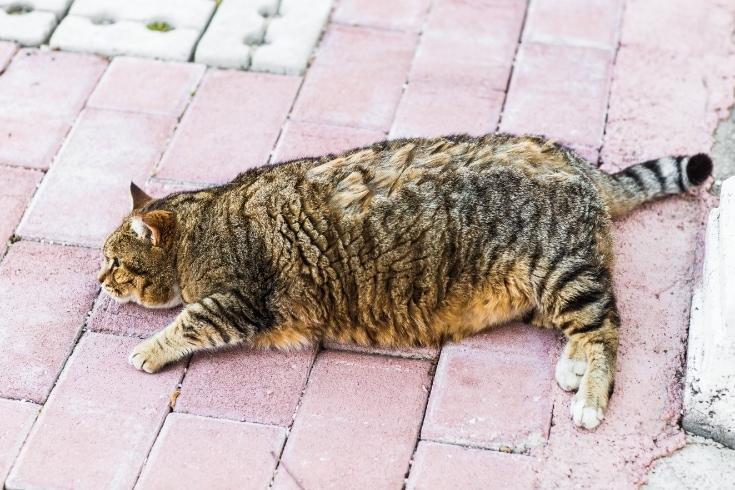
If your cat is carrying too much weight, she might develop chronic joint problems, such as arthritis as she gets older. Painful joints affect the cat’s mobility and impact her quality of life because she will no longer be able to play, jump, and even sleep comfortably.
Heart Disease
An overweight or obese cat’s heart has to work much harder, which can lead to the development of chronic heart diseases, heart murmurs, and a much shorter lifespan. Obese cats have what’s termed impaired pulmonary function because of their decreased lung volume. Serious heart conditions like cardiac hypertrophy, hypertension, myocardial hypoxia, and vascular hypertrophy can all affect overweight cats.
Respiratory Issues
Your cat can’t tell you that she feels short of breath, but excess fat increases pressure on the cat’s lungs, which interferes with their normal function, leaving your cat unable to breathe as freely as she should.
If the cat finds it difficult to breathe, her body won’t receive the oxygen it needs for exercise and even daily living.
Liver Disease
A severe health condition called hepatic lipidosis is a common cause of liver failure in cats. although the condition can affect any cat, it’s most commonly seen in middle-aged overweight felines.
Urinary Tract Issues
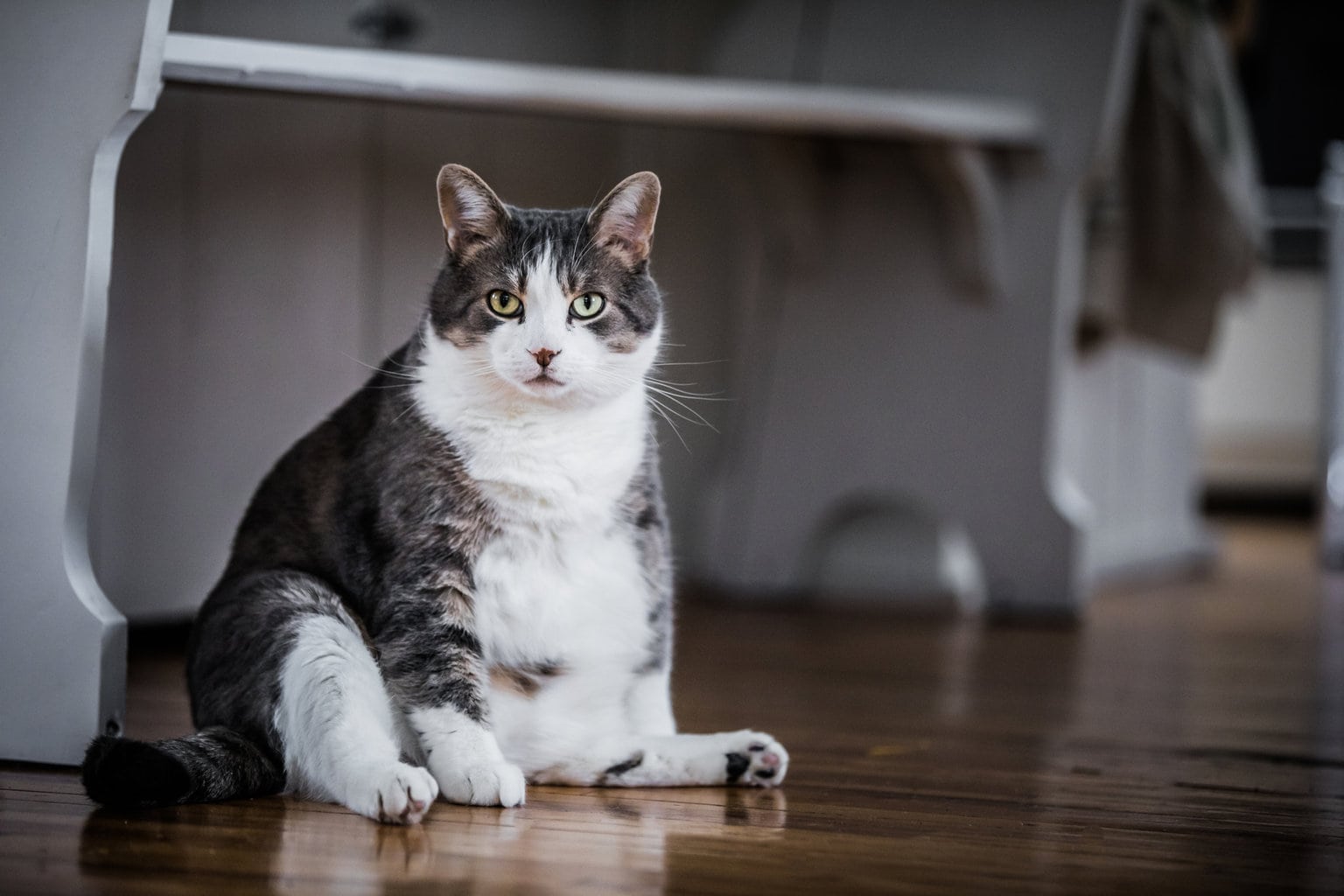
Middle-aged overweight cats that get very little exercise, don’t have access to going outside, and use an indoor litter box can be prone to lower urinary tract diseases or FLUTD. In addition, obese cats commonly develop painful bladder stones.
Skin And Coat Problems
Obese cats are less likely to spend time or be physically able to groom themselves properly, leading to coat problems like matting, which in turn causes skin infections and allergies.
Digestive Problems
Obese cats can develop digestive problems and often suffer from constipation, especially if fed an exclusively dry diet. You can help mitigate that problem by feeding the cat a low-calorie diet that contains wet food as well as kibble.
Decreased Lifespan
An overweight cat can generally expect to live for a much shorter time than a fit, active feline, usually because of the cumulative effect on the cat’s overall health and immune system.
Exercise Intolerance
Just like overweight people, an obese cat won’t be able to tolerate much exercise without becoming out of breath and distressed. Unfortunately, that is a vicious circle, since a fat cat needs to take more exercise to lose weight, but will be reluctant to do so if she cannot breathe properly.
Immune System Suppression
Research shows that obese cats often develop mild bone marrow suppression, making their immune system less effective. If the cat’s immune system is compromised, she won’t be able to fight off diseases and infections effectively, potentially making her a sickly cat with a shorter life expectancy.
Surgical Risks
An obese cat has much more fat in its body, which makes surgery more difficult since the fat blocks areas that the vet needs to get to during an operation. That means the procedure will take longer so the cat will need a longer anesthetic, which increases risk and prolongs the cat’s recovery time.
How Do You Help A Cat Lose Weight?
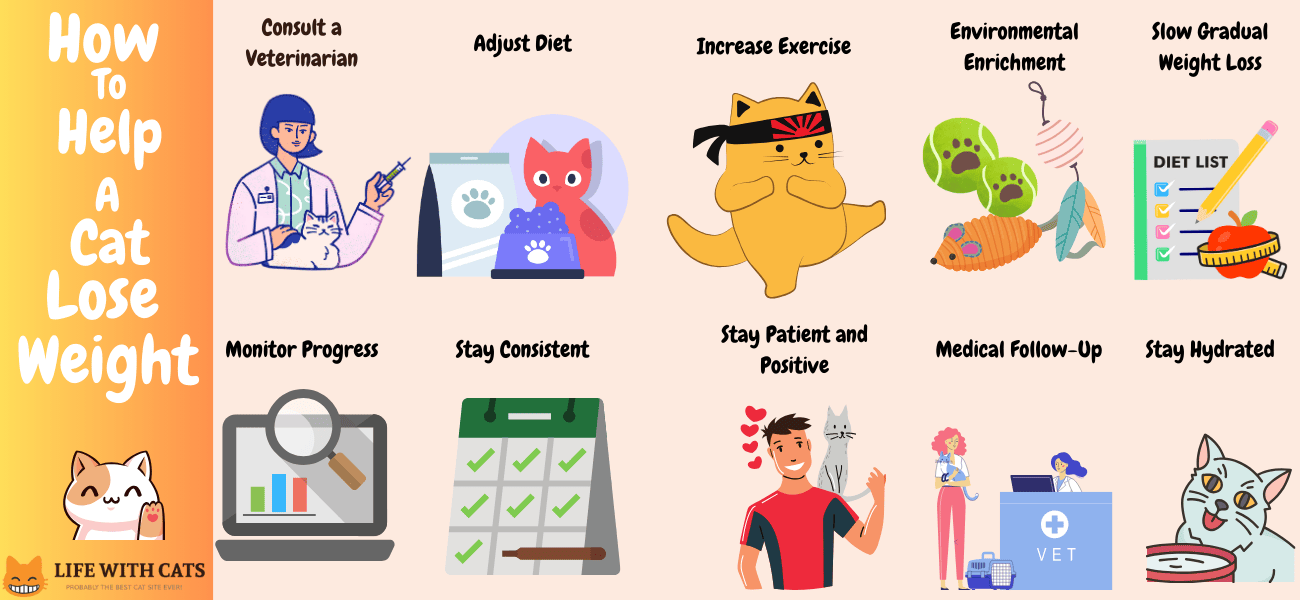
Cat weight loss is best managed through a combination of tactics, including exercise, diet, and veterinary advice.
It’s essential to have a clear plan and set weight loss goals for your pet so that you can keep track of your furry friend’s progress.
Consult A Veterinarian
Your first port of call should be your vet clinic to ask for professional advice on how much weight your cat needs to lose and the best way to go about achieving that. Your vet will also be able to advise you on the best weight loss prescription diet for your pet.
Adjust Diet
As mentioned above, your vet might prescribe a cat diet plan, including special cat weight-loss food. Before you begin your cat’s new feeding regimen, be sure to ask your vet how to put my cat on a diet and make any adjustments necessary.
Choose A High-Quality, Balanced Diet
It goes without saying that you should choose a high-quality, balanced diet for your cat that includes a good nutritional balance but is also geared toward weight loss.
Measure Portions
It’s very easy to feed your cat too much, so you must take the time to measure the portions and weigh them, following the manufacturer’s guidelines on the product packaging. Don’t just use a plastic cup to measure the food, weigh it too. It’s easy to accidentally put a little too much kibble into a plastic container without realizing it, but a set of weighing scales doesn’t lie!
Control Treats
Many cat treats contain an alarming amount of calories, so don’t go overboard with treating your feline friend. When buying treats for your cat, look carefully at the nutritional information on the packet to see how many calories each treat contains, and pick the lower-calorie options.
Increase Exercise
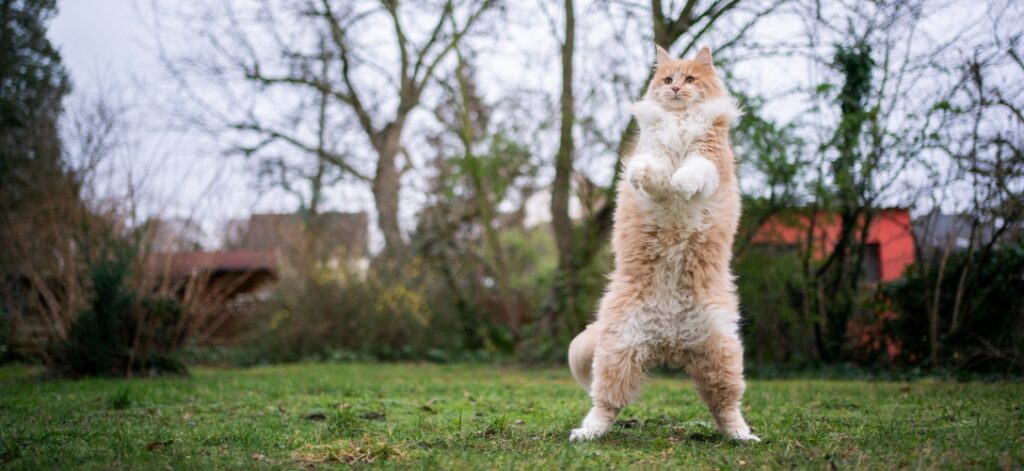
Encouraging your cat to take more exercise is crucial in helping her burn off excess calories and prevent further weight gain.
There are many ways of getting your cat to be more active, and you can make exercise time fun, too!
Interactive Play
Your cat is more likely to exercise if you join in, so invest in a selection of interactive cat toys, such as feather wands, laser pens, and the like.
For example, although neither of my cats is overweight, they both enjoy a game and spend much of their time outside, especially during the summer months. That exercise keeps them fit, healthy, and the correct weight for their size.
Cat Trees And Scratching Posts
Using a scratching post is a great way for your cat to stretch and burn off some excess calories, as well as satisfy her natural instincts and keep her claws in good order. Many scratch posts incorporate perches and hammocks, encouraging your cat to climb and be more active.
Regular Playtime
Cats love to have a regular routine for their day, so you can include a couple of short exercise sessions in your cat’s schedule. Choose times when your cat is not too sleepy and naturally becomes more active, such as early in the morning or in the early evening.
Environmental Enrichment
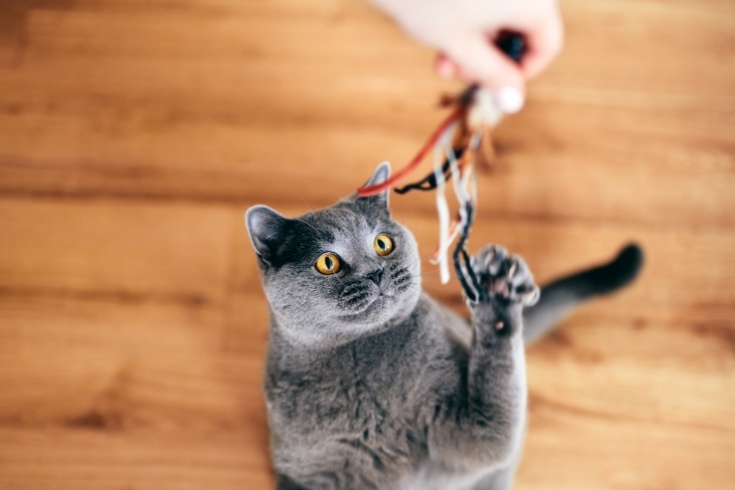
It’s simply not practical for you to be there every minute of the day to ensure your cat gets enough exercise, especially if you’re out at work during the day. However, you can enrich your cat’s environment by providing her with a variety of toys, including puzzle boxes, catnip mice, and the like, that she can play with while you’re not around.
Rotate Toys
So that your cat doesn’t get bored with the same toys, get into the habit of rotating them every few days. That helps to keep things fresh for your cat and makes her more likely to play with the toy you’ve left out for her.
Window Views
Indoor cats can enjoy a more enriched environment simply by having a window view to enjoy. Your cat can sit on a windowsill and watch the world go by outside, including fluttering birds, and raindrops trickling down the window pane, which can help keep a mentally active and anxiety-free.
Slow Gradual Weight Loss
Although you want your cat to lose weight, you shouldn’t try to get her to shed too much weight too quickly, as that can lead to its own set of problems. In addition, your cat will be stressed if she’s constantly hungry and could resort to hunting for her own food outside, or even taking trips to your neighbors in search of a meal!
Monitor Progress
It’s a good idea to keep a diary to record your cat’s weight loss. If you don’t have a suitable set of scales at home, pop into your vet clinic and use theirs. That way, you can know if your cat’s diet and exercise regimen are working and make any necessary adjustments as you go.
Stay Consistent
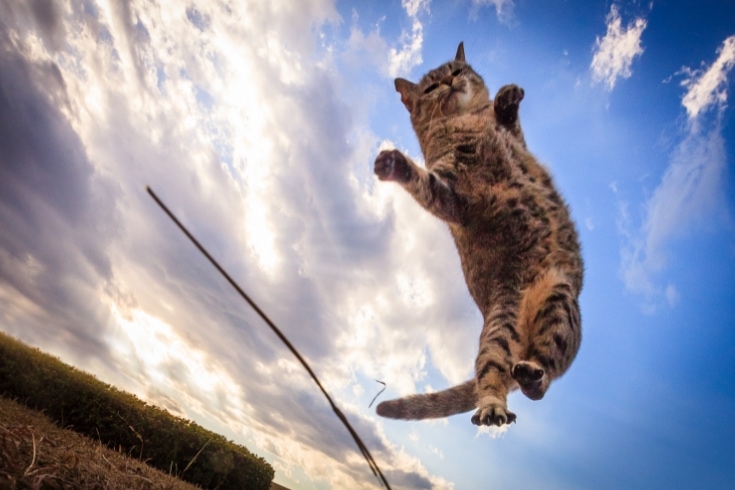
Don’t chop and change your approach to your cat’s exercise and diet regimen. Stay consistent and stick with your and your vet’s weight loss plan.
Stay Patient And Positive
Don’t get impatient if your cat doesn’t lose weight as quickly as you want. Gradual weight loss is much better for your pet’s health, and you don’t want to make matters worse. Be positive when encouraging your cat to exercise, and make sessions fun for both of you.
Stay Hydrated
Cats are notorious for not drinking enough water, so it’s essential to encourage your cat to stay hydrated by including some wet food in her diet and ensuring clean, fresh water is available for your pet 24/7.
Medical Follow-Up
As your cat’s weight loss program progresses, keep up with vet check appointments. That way, you can be sure that Kitty is losing weight at a healthy rate and is showing no underlying health problems associated with her weight loss and new exercise and feeding regime.
Does Training Help In Cats’ Weight Loss?
Yes, training can help in cats’ weight loss in a number of ways, including increased physical activity, bonding time with their owners, and mental stimulation. Keep reading to learn how training your cat can help her lose weight and become more obedient.
Increased Physical Activity
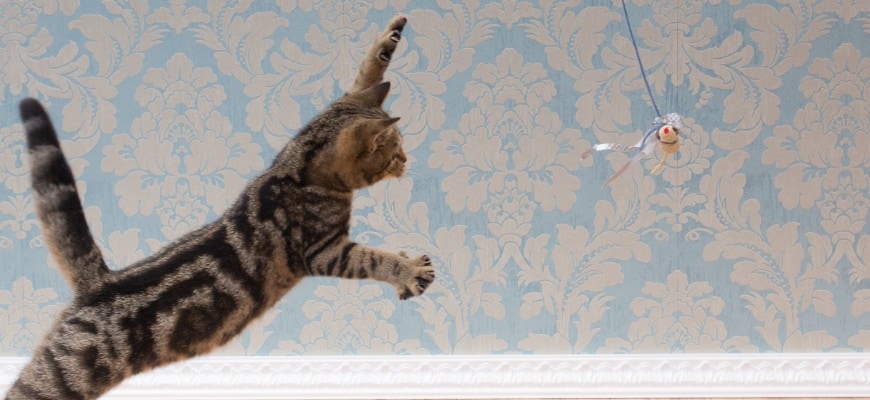
Many cat training activities demand physical activity. For example, you can train your cat to fetch a ball, jump through a hoop, or complete a simple agility course. Increased physical activity helps your cat burn off calories and shed excess weight.
Mental Stimulation
Another big plus point of training your cat is that learning new tricks and cues can provide valuable mental stimulation for your pet, preventing her from becoming bored and comfort-eating.
Bonding Time
Being on a diet and having more exercise incorporated into her daily routine can be quite stressful for your overweight cat, and training her to perform simple tricks is a great way of including valuable bonding time in your feline friend’s day.
Controlled Diet
Controlling your cat’s diet, rewarding her with low-calorie treats, or substituting an edible reward for playtime with a toy is an excellent way of encouraging weight loss through training.
Behavioral Changes
Behavioral changes such as performing new tricks, becoming more active, and spending more time playing with toys are great ways of using training to facilitate weight loss.
Gradual Exercise Increase
Start by training your cat to perform simple, basic commands, gradually increasing the difficulty of the tricks as she becomes more confident. That way, you’re gradually increasing the amount of exercise your pet gets, helping to boost weight loss and fitness.
What Cat Training Can Help A Cat Lose Weight?
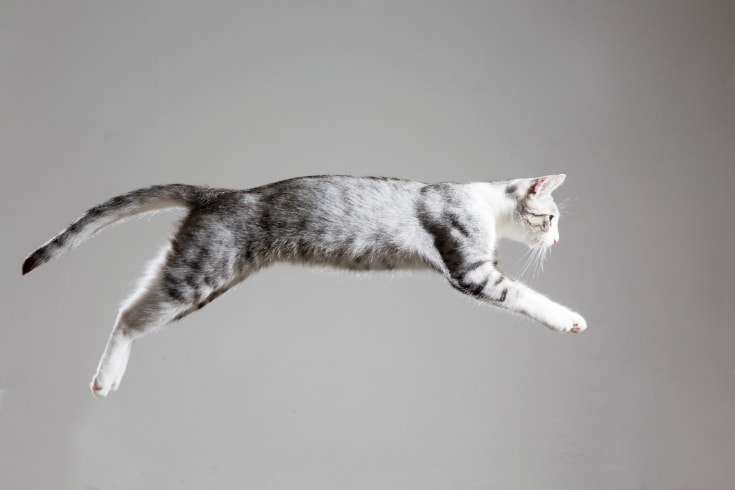
Cat training techniques and exercises that can help a cat lose weight include interactive play, clicker training, and having fun with food puzzle toys containing low-calorie treats and tidbits.
Many cat training exercises involve physical exercises that are great for burning off calories in a fun way that your cat will love.
Interactive Play
Engaging in interactive play sessions with your cat using toys like feather wands or laser pointers can encourage your cat to exercise and help burn calories. Cats love to chase and pounce, making these play sessions a fun way to get your pet moving.
Food Puzzle Toys
Incorporating food puzzle toys into your cat’s routine can turn mealtime into a mentally and physically stimulating activity. These toys encourage your cat to “hunt” for her food, slowing down her eating and providing your furry friend with more exercise in the process.
Clicker Training
Clicker training involves using a clicker to tell your cat she’s performed a desired behavior. By rewarding your cat with low-calorie treats during training sessions, you can encourage her to perform exercises that aid in weight loss.
Obstacle Course
Setting up a simple obstacle course in your home can encourage your cat to climb, jump, and navigate her way through various simple challenges. This type of activity helps improve your pet’s agility and promotes weight loss while having fun.
Target Training
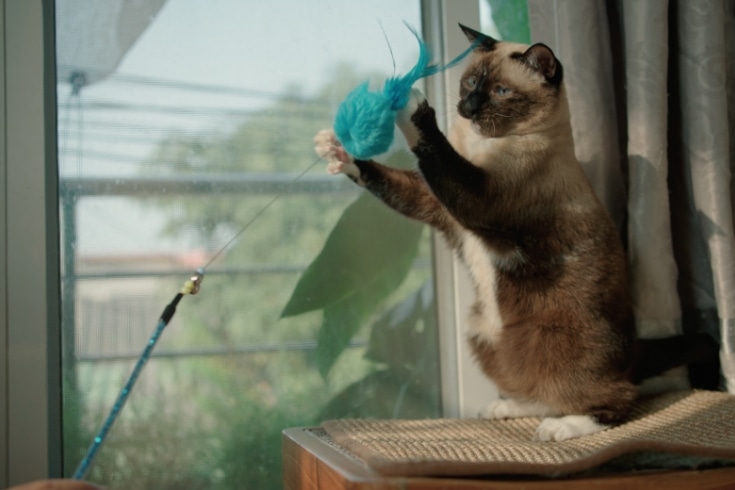
Target training involves using a wand with a ball or other object on one end to teach your cat to touch a specific object with her nose or paw. That can be a foundation for teaching more complex exercises and commands while encouraging your pet’s physical activity.
Fetch
Contrary to popular belief, some cats can be trained to play fetch! Tossing a lightweight toy for your cat to retrieve and return to you can provide her with both mental and physical stimulation.
Cat Treadmill
If your cat is comfortable with the idea, a cat treadmill can be a unique way to help them shed pounds. Remember, it’s important to introduce the treadmill gradually and ensure your cat’s safety at all times.
Vertical Play
Cats love to climb, so providing vertical spaces like cat trees or perches encourages them to jump and explore, aiding weight loss and tapping into your pet’s natural instincts.
Chase And Hunt Games
Mimicking the thrill of a hunt by using toys that simulate prey can really get your cat moving! For example, dragging a feather toy or a catnip mouse on a string can trigger your cat’s predatory instincts and soon have her stalking and pouncing, burning up calories at the same time!
Staircase Exercises
A staircase can make an excellent exercise area for your cat! Encourage your cat to climb up and down the stairs, but always supervise your pet to prevent accidents.
Tug Of War
Playing tug of war with your cat using a soft toy can be a great fun workout for you and your pet. Just remember to use gentle movements to avoid overexerting your cat, especially if she’s very overweight and stop the game if your pet becomes short of breath.
Social Play
Batting at toys or crawling around on the floor can motivate a lazy cat to join in the fun, and your active involvement can make playtime more enticing and beneficial for your pet.
FAQs
In this part of our guide on cat obesity and weight loss, we answer some of the most commonly asked questions on the subject.
Can Cat Obesity Lead To Serious Health Complications?
Definitely, just like in humans, obesity in cats can lead to a range of serious health issues, including diabetes, heart problems, joint pain, a suppressed immune system, and even a shortened lifespan. So, you can see that maintaining a healthy weight for your cat is crucial to her overall well-being.
Is There A Link Between Indoor Lifestyle And Cat Obesity?
Yes, a definite link exists between cats that live a primarily indoor lifestyle and obesity.
Cats living indoors tend to be less active than those with outdoor access, and a lack of physical activity can contribute to weight gain. So, if you have an indoor cat, providing opportunities for play, exercise, and mental stimulation indoors can help counter this.
Can Stress And Anxiety Contribute To Cat Weight Gain?
Absolutely, stress and anxiety can contribute to cat weight. Just like some humans turn to food for comfort, cats under stress might overeat. That can be due to changes in their environment, routine, or even interactions with other pets, and addressing those underlying stressors can be important for weight management.
What Are The Potential Consequences Of Rapid Cat Weight Loss?
Rapid weight loss in cats can be concerning, potentially leading to liver problems, muscle loss, and other health issues. Gradual, controlled weight loss under veterinary supervision is safer and healthier for your feline friend.
Should I Consult A Veterinarian Before Changing My Cat’s Diet?
Yes, consulting a vet before you change your cat’s diet is a great idea!
Cats have unique dietary requirements, and sudden diet changes can upset their digestion. A vet can provide tailored advice, recommend the right type and amount of food, and monitor your cat’s progress throughout her weight loss program.
What Role Does Exercise Play In Cat Weight Management?
Exercise is essential for weight management in cats. Playtime, interactive toys, and climbing places can all help keep your cat active, and regular physical activity burns calories and helps maintain muscle mass, so it’s a win-win for your pet!
Are Certain Cat Breeds More Susceptible To Obesity?
Yes, some cat breeds are more prone to obesity than others, mainly due to factors like genetics and metabolism. For example, breeds like the Maine Coon and Scottish Fold have a higher risk of becoming obese than Siamese or Bengal cats. However, regardless of breed, cats can become obese if their diet and lifestyle aren’t adequately managed.
Can I Use Treats As Part Of A Weight Loss Plan For My Cat?
Yes, you can include treats as part of a cat weight loss program, but it’s important to do so mindfully. So, you should opt for low-calorie treats and use them sparingly. Watch out for treats specifically designed for weight management, and remember, treats shouldn’t make up more than 10% of your cat’s daily caloric intake.
How Can I Prevent My Cat From Regaining Lost Weight?
Preventing your cat from regaining the weight she’s lost involves maintaining a consistent diet and exercise routine. Monitor your cat’s weight regularly, adjust her meal portions as needed, and provide an enriched environment to keep your pet mentally stimulated and active.
Are There Any Specialized Weight Loss Programs For Cats?
Yes, some vet clinics offer specialized weight loss programs for cats. These programs often involve regular check-ins with the vet, personalized diet plans, and tailored exercise recommendations, and they can be very effective in helping your cat reach and maintain a healthy weight.
Conclusion
Maintaining a healthy weight for your cat’s age, size, and breed is critical if your pet is to live a long and healthy life. Obese cats often suffer from many severe health conditions, including diabetes, respiratory problems, heart disease, joint problems, and immune system suppression, and many have a shorter lifespan than a healthy cat of the correct weight.
You can give your beloved feline friend a longer, healthier life by keeping her active through daily training and playtime sessions and feeding her a nutritious, balanced diet in the correct quantities. So, you know what to do if you have a tubby tabby!